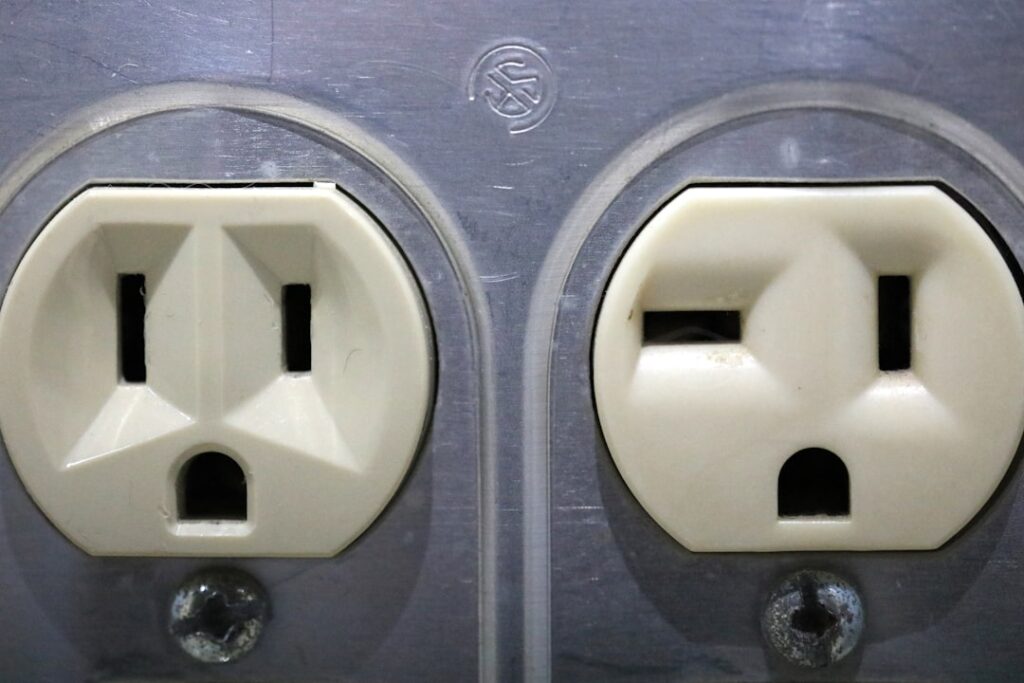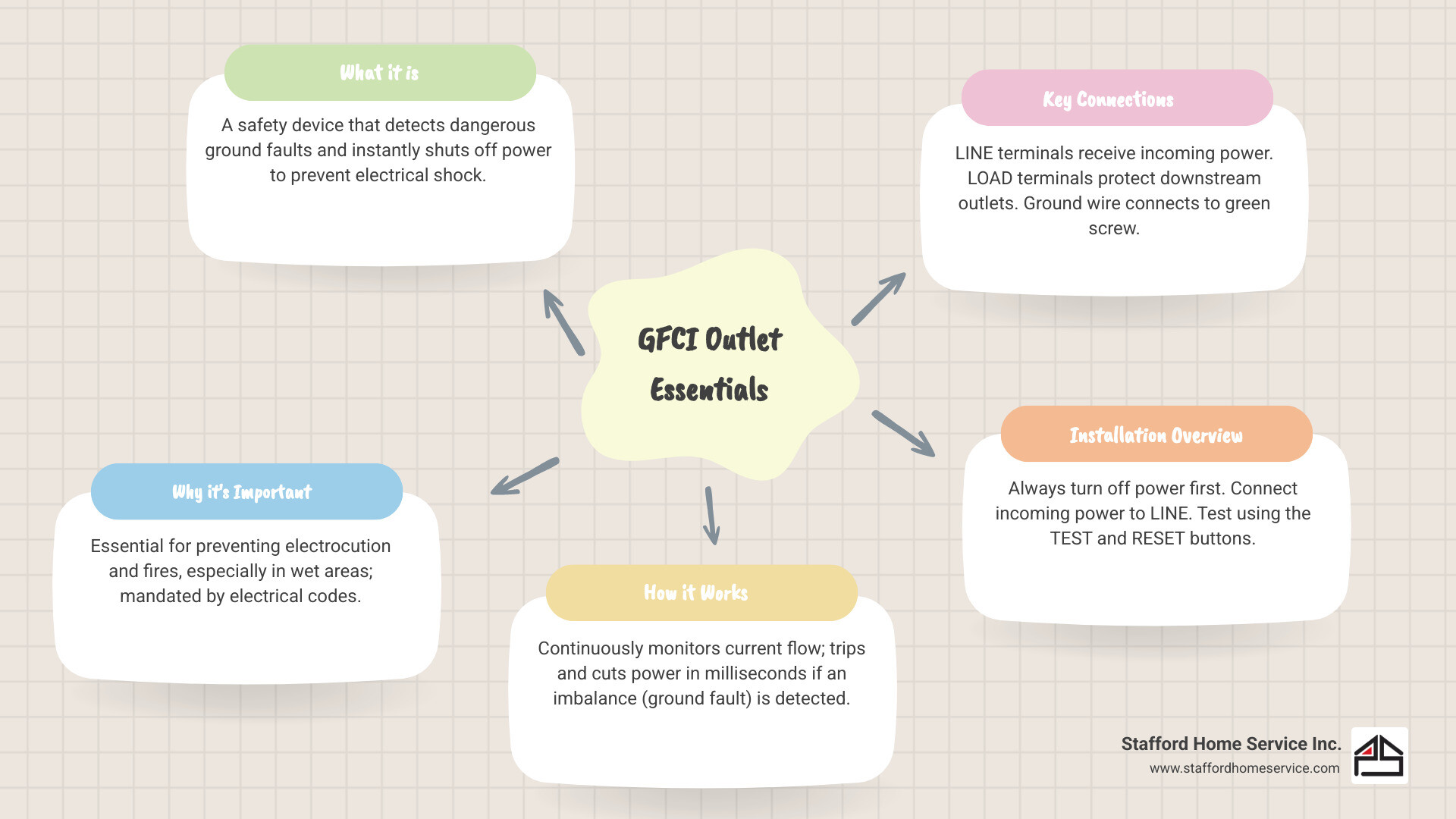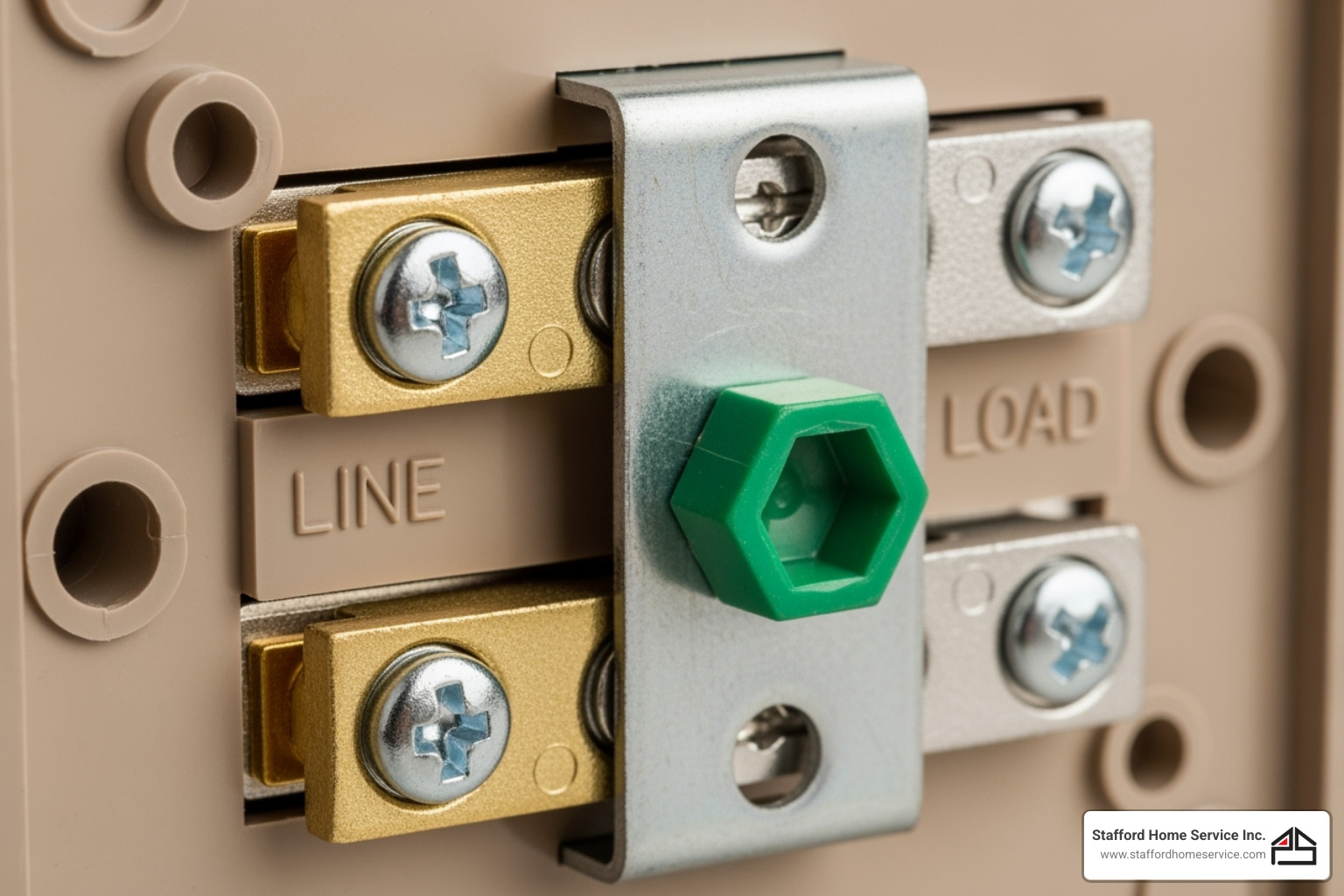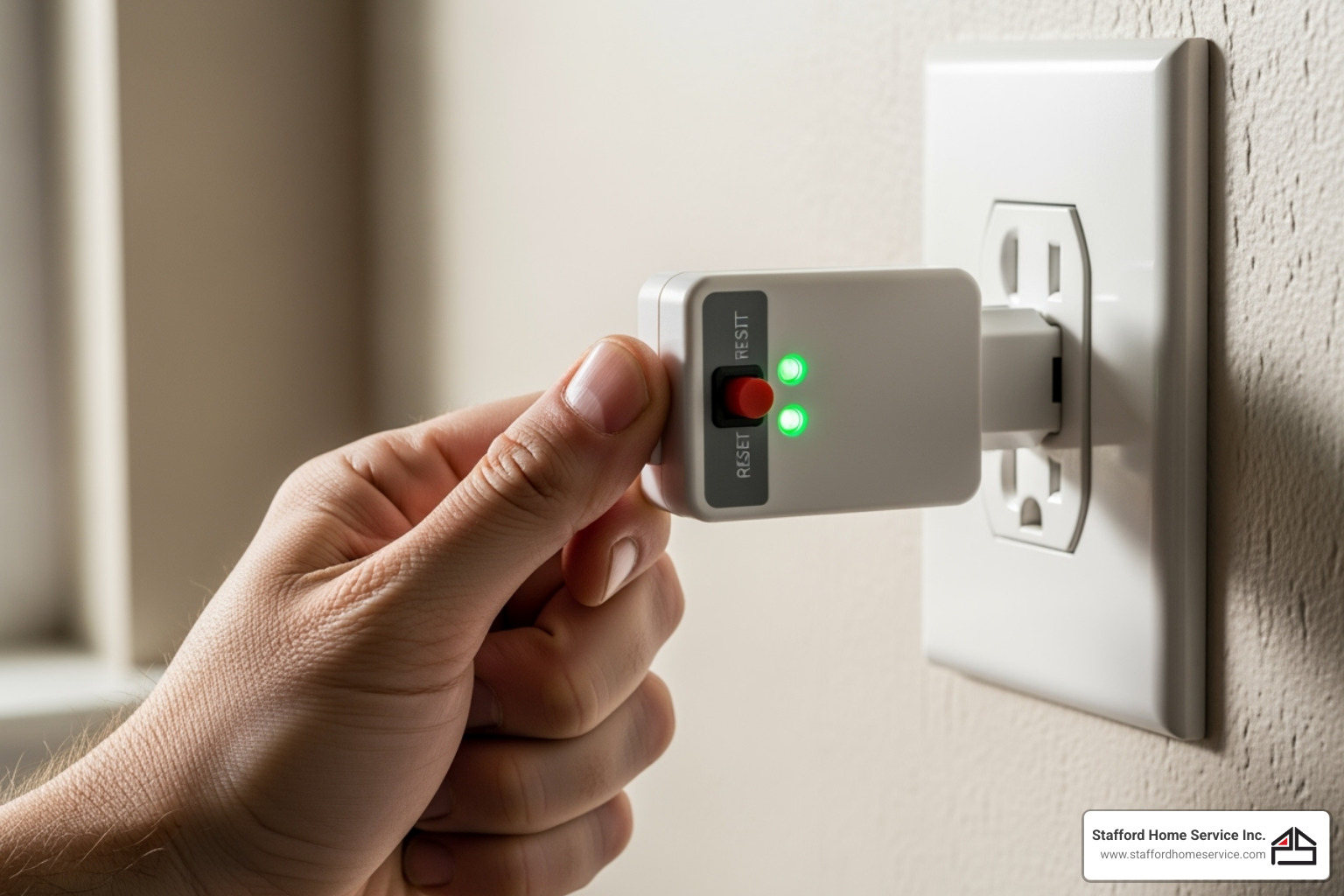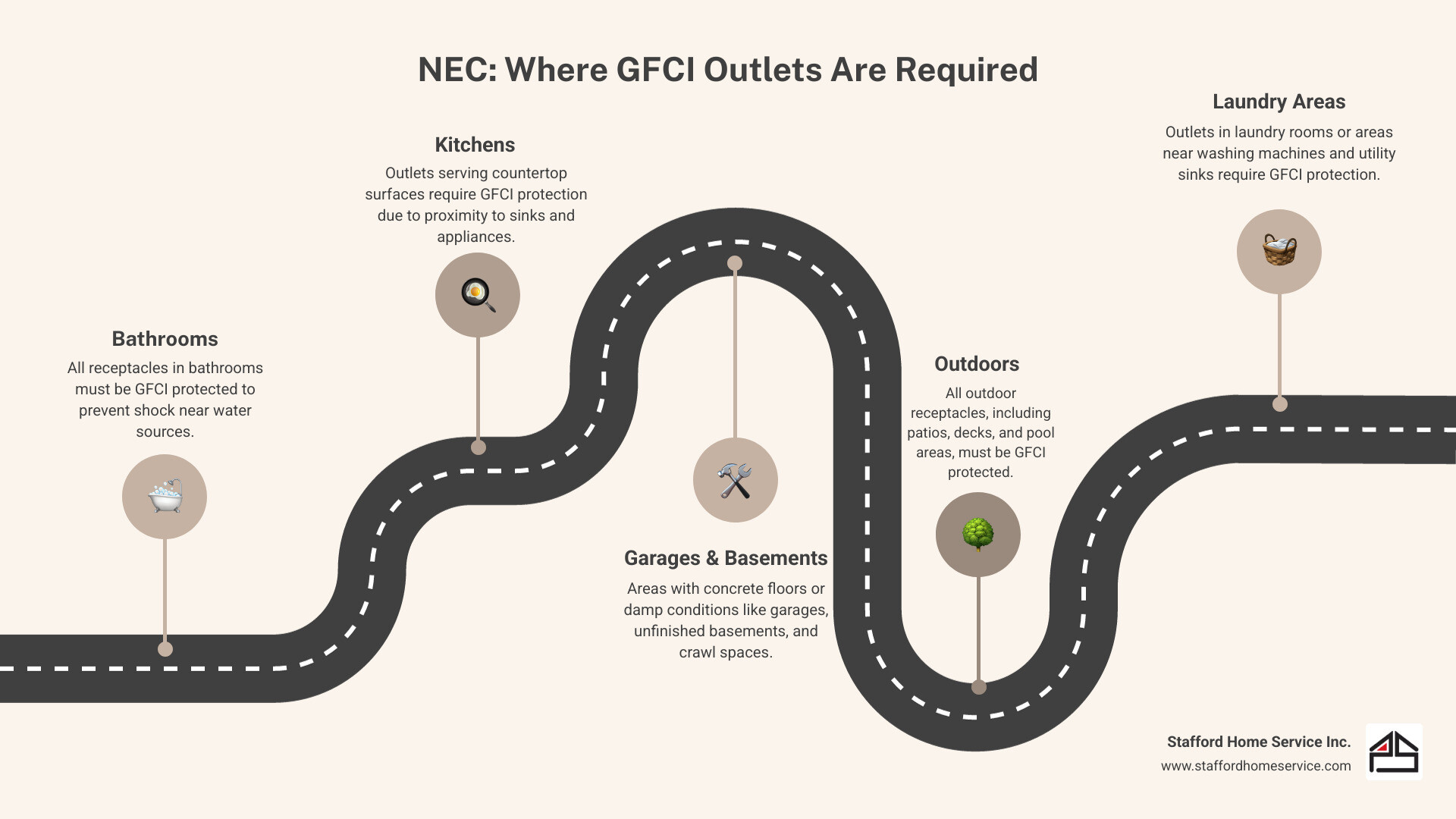Understanding GFCI Outlets: Your First Line of Defense
A GFCI outlet installation is a critical safety upgrade that protects your family from electrical shock and fire. These specialized outlets are your first line of defense against dangerous ground faults, shutting off power in milliseconds to prevent serious injury.
What is a GFCI Outlet and Why is it Important?
A GFCI, or Ground Fault Circuit Interrupter, is an intelligent outlet that constantly monitors electrical current. In a normal circuit, the electricity flowing to an appliance (through the “hot” wire) should be identical to the current flowing back (through the “neutral” wire).
If electricity takes an unintended path—through water, a damaged cord, or a person—it creates a “ground fault.” The GFCI detects this tiny imbalance (as little as 4-6 milliamperes) and instantly “trips,” cutting off power. This rapid response is fast enough to prevent electrocution.
Beyond shock prevention, GFCIs also provide fire protection by stopping faulty wiring or appliances from overheating. The National Electrical Code (NEC) requires GFCI protection in all wet or damp locations, such as bathrooms, kitchens, garages, and outdoor areas. They are essential safety devices in any modern home.
To learn more about how GFCIs keep us safe, you can check out More on GFCI safety.
Gearing Up: Tools, Materials, and Safety First
Smart preparation is the secret to a successful and safe GFCI outlet installation. Before you begin, gather all your tools and materials and review the critical safety precautions.
Essential Tools and Materials
- GFCI Receptacle: Choose a 15-amp or 20-amp model to match your circuit. Use Weather-Resistant (WR) types for outdoors and Tamper-Resistant (TR) models for homes with children.
- Voltage Tester: A non-contact voltage tester is essential for confirming the power is off.
- Screwdrivers: Both Phillips head and flathead.
- Wire Strippers: To remove wire insulation cleanly.
- Needle-Nose Pliers: For bending wire ends.
- Electrical Tape and Wire Nuts: For securing connections.
- New Faceplate: To ensure a perfect fit with the new outlet.
Critical Safety Precautions Before You Begin
Electricity doesn’t give second chances. Your safety is the top priority.
- Turn Off Power: Locate your circuit breaker panel or fuse box. Turn off the breaker that controls the outlet you’re working on. If breakers aren’t labeled, plug a lamp into the outlet and flip breakers until the light goes out.
- Verify Power is Off: This is the most important step. Use your non-contact voltage tester on a known live outlet to confirm it’s working. Then, test the target outlet. The tester should not light up or beep. Double-check by testing it on the live outlet again.
- Work Dry: Ensure your hands, tools, and the work area are completely dry. Water and electricity are a dangerous combination. Postpone the work if the area is damp.
Step-by-Step GFCI Outlet Installation Guide
With your tools ready and safety checks complete, you can begin the GFCI outlet installation. The most critical part is understanding the LINE and LOAD terminals on the back of the outlet.
- LINE Terminals: Connect to the incoming power wires from your circuit breaker. This is where power enters the GFCI.
- LOAD Terminals: Used only if you want to protect other standard outlets downstream on the same circuit. Power flows out from here to the other outlets.
Mixing up LINE and LOAD wires is the most common installation mistake and will prevent the GFCI from working.
Replacing an Existing Outlet: A Basic GFCI Outlet Installation
- Confirm Power is Off: Double-check with your voltage tester.
- Remove Old Outlet: Unscrew the faceplate and mounting screws. Gently pull the outlet from the box. Take a photo of the wiring before disconnecting anything.
- Disconnect Wires: Loosen the terminal screws and remove the old wires (typically black, white, and bare copper/green).
- Connect the GFCI:
- Connect the ground wire (bare copper or green) to the green screw.
- Connect the incoming hot wire (black) to the brass LINE terminal screw.
- Connect the incoming neutral wire (white) to the silver LINE terminal screw.
- Connect Downstream Wires (Optional): If you have a second set of wires feeding other outlets you want to protect, connect them to the LOAD terminals (black to brass, white to silver). If not, leave the yellow tape covering the LOAD terminals.
- Finish Up: Carefully fold the wires into the box, secure the GFCI, attach the faceplate, and restore power at the breaker.
Installing a New GFCI on an Unprotected Circuit
Adding a GFCI outlet where one doesn’t exist is a more advanced project. It involves identifying a power source, running new electrical cable through walls (a process called “fishing”), and cutting an opening for a new electrical box. This can be complex, especially if you encounter fire blocks inside the wall. If you’re not comfortable with these steps, it’s best to call a professional. Many of our Minneapolis-area clients trust us with this type of installation.
How to Properly Connect Wires to a GFCI Outlet
For a safe, lasting connection, strip about 3/4 inch of insulation from each wire. Bend the wire ends into a hook shape with pliers and wrap them clockwise around the terminal screws. Tighten each screw securely so the wire cannot be pulled out. Loose connections are a fire hazard.
Testing, Troubleshooting, and Maintenance
After your GFCI outlet installation, testing is an essential final step to ensure it’s working correctly.
How to Test Your New GFCI Outlet
- With power restored, press the RESET button. The indicator light should turn on.
- Plug in a small lamp or radio to confirm power is flowing.
- Press the TEST button. The device should shut off immediately, and the indicator light should go out.
- Press RESET again to restore power.
- For extra assurance, use a plug-in receptacle tester to verify correct wiring.
- If you connected downstream outlets, test them by pressing the TEST button on the GFCI; they should lose power too. Apply the “GFCI Protected” stickers to these outlets.
Troubleshooting Common GFCI Issues
- GFCI Won’t Reset: Check that the circuit breaker is fully ON. The most common cause is reversed LINE and LOAD wires. Turn off the power and correct the wiring. It could also be detecting a real ground fault or moisture in the box.
- GFCI Trips Frequently: This often means it’s working correctly and detecting a problem. Unplug all appliances from the GFCI and any protected outlets. If it resets, plug devices in one by one to find the faulty appliance. Persistent “nuisance tripping” on older GFCIs may mean it’s time for a replacement.
If you can’t solve the issue, it’s safest to call a professional.
GFCI Maintenance and Replacement
A GFCI is a durable device, but it won’t last forever.
- Monthly Testing: Perform the TEST/RESET procedure every month to ensure the internal safety mechanism is functional.
- When to Replace: Replace your GFCI immediately if it fails the monthly test, shows any signs of damage (cracks, burn marks), or is over 10-15 years old. Newer GFCIs are self-testing, but a manual test is still recommended. A failed GFCI offers no protection, so when in doubt, replace it.
Code Requirements and Special Location Considerations
The National Electrical Code (NEC) mandates GFCI outlet installation in any area where electricity and water could potentially meet. Following these codes is essential for your family’s safety.
Where are GFCI Outlets Required by Code?
As a general rule, GFCI protection is required in:
- Bathrooms: All receptacles.
- Kitchens: All receptacles serving countertop surfaces and any within 6 feet of a sink.
- Garages and Accessory Buildings: All 15- and 20-amp receptacles.
- Outdoors: All receptacles.
- Unfinished Basements and Crawl Spaces: All receptacles.
- Laundry Areas: All receptacles.
- Boathouses and Docks: All receptacles.
For complete details, you can review the NEC requirements for GFCI protection.
Special Considerations for Kitchens, Bathrooms, and Outdoors
Some locations require more than just a standard GFCI.
- Kitchens: In addition to GFCIs, modern codes require at least two 20-amp circuits for countertop appliances to prevent overloads.
- Bathrooms: Every outlet must be GFCI protected, with no exceptions.
- Outdoors: Use Weather-Resistant (WR) outlets designed to withstand UV rays and moisture. You must also install an “in-use” cover (a bubble cover) that protects the plug and cord from rain and snow even when something is plugged in. Proper sealing around the electrical box is also crucial to keep water out.
Frequently Asked Questions about GFCI Installation
Here are answers to the most common questions we hear about GFCI outlet installation.
What’s the difference between the LINE and LOAD terminals?
This is the most critical detail of a GFCI outlet installation.
- LINE terminals are the “input” for power coming from your circuit breaker.
- LOAD terminals are the “output” used to send GFCI-protected power to other standard outlets downstream.
If you connect the incoming power wires to the LOAD terminals by mistake, the GFCI will not reset or provide power. If you are only protecting the single GFCI outlet, do not use the LOAD terminals at all.
Can I install a GFCI outlet in a box without a ground wire?
Yes. A GFCI provides shock protection even without a ground wire because it detects imbalances between the hot and neutral wires. However, you must follow two rules:
- Do not connect any wires to the LOAD terminals. The GFCI can only protect itself in this setup.
- You must apply the “No Equipment Ground” sticker (included with the GFCI) to the faceplate.
This provides vital shock protection for older homes, but a properly grounded circuit remains the safest option.
Why does my new GFCI outlet trip immediately?
If a new GFCI won’t reset, it’s usually for one of these reasons:
- Reversed LINE/LOAD Wires: This is the most common cause. Ensure the incoming power is connected to the LINE terminals.
- A Real Ground Fault: The GFCI may be doing its job. Unplug all appliances on the circuit to see if one of them is causing the fault.
- Moisture in the Box: Water or condensation can cause a trip. Turn off the power and let the box dry out completely.
- Faulty GFCI: In rare cases, the outlet itself may be defective from the factory.
If you’ve checked these and still have issues, it’s time to call an electrician.
Conclusion: Powering Your Home Safely
Completing a GFCI outlet installation is a rewarding project that significantly boosts your home’s electrical safety. By following this guide, you can protect your family from dangerous ground faults in key areas like kitchens, bathrooms, and garages.
While many homeowners can handle a basic replacement, electrical work demands respect. Complex wiring, troubleshooting, or installing new circuits are often best left to professionals. There’s no substitute for the peace of mind that comes with knowing the job was done right.
For homeowners in Minneapolis, Edina, Golden Valley, Minnetonka, Plymouth, St. Louis Park, and the surrounding areas, the experienced electricians at Stafford Home Service Inc. are here to help. We are committed to quality workmanship and complete customer satisfaction for any electrical challenge, big or small.
Whether you DIY or call us for help, ensuring your home has GFCI protection is a priceless investment in your family’s safety.
Contact us for professional electrical services



